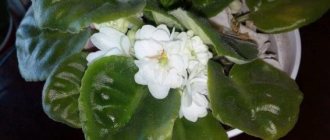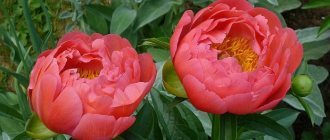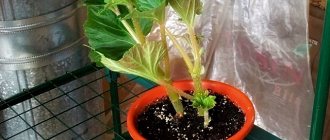Author: Elena N. https://floristics.info/ru/index.php?option=com_contact&view=contact&id=19 Category: Houseplants Published: February 27, 2019Last edits: January 11, 2021
- When to plant
- Growing conditions
- Bacopa caroliniana
plant (lat. Bacopa) belongs to the genus of the Plantain family, which includes more than 100 species of aquatic, water-loving, succulent creeping rhizomatous perennials. Bacopa is native to South America and the Canary Islands. In nature, bacopa grows on the marshy shores of reservoirs in the tropics and subtropics of Asia, Australia, America and Africa. The second name for bacopa is sutera. The bacopa flower has been in cultivation since 1993. It is also grown in temperate climates, using it as an ampel and as a ground cover plant.
Planting and caring for bacopa
- Flowering: abundant, gradually weakening, but then growing again.
- Planting: sowing seeds for seedlings - in March, planting seedlings in open ground or in hanging structures - in mid-May.
- Lighting: bright sun or partial shade in areas protected from strong winds.
- Soil: drained, humus-rich fertile soils with a slightly acidic reaction.
- Watering: frequent and plentiful, especially during drought.
- Feeding: Only young plants need feeding from spring to September. Complex mineral fertilizers are used in turn with organic ones.
- Pruning and pinching: for better tillering, shoots are pinched from time to time, and lashes that are too long are shortened. The plant is pruned when flowering becomes scarce and the lower part of the shoots becomes woody.
- Reproduction: by seeds, from January to April - by apical cuttings.
- Pests: at home - whiteflies, aphids and spider mites.
- Diseases: gray rot, sooty or mold fungus.
Read more about growing bacopa below.
Diseases and pests
Among the diseases of Bacopa, the most common are gray mold and fungus. They arise due to several flower bushes planted too densely or waterlogging of the soil.
Yes, Bacopa loves moisture very much, but if it does not evaporate and sunlight does not reach the soil due to dense greenery, fungi and gray rot appear. You should thin out the thick stems to open up the soil, and don’t forget to loosen it. It won’t hurt to treat the shoots with a fungicide.
Pests occur most often during indoor wintering, when the humidity is low and the temperature is above 15 degrees. There is enough heat and dry air for the appearance of sucking pests - aphids, whiteflies and spider mites. If a plant overwinters in not very suitable temperature conditions, it is important to inspect it for timely detection of pests and control them. Parasites can be destroyed by 2-3 acaricide treatment procedures.
Bacopa is a wonderful decoration. In the garden it will create a flowering carpet; on balconies or loggias it will act as a hanging carpet - an avalanche of long flowering vines. Bacopa, which does not require much effort to care for and grow, will delight its owner with greenery and color until the cold weather.
Botanical description
The stems of bacopa are thin, creeping, creeping or lodging, reaching a length of 60 cm and growing greatly in width. The leaves are small, broadly elliptic or ovate, green or olive-green in color, linear, with a serrated edge. Ampelous bacopa blooms with axillary bell-shaped or tubular flowers (depending on the type and variety), small or large, simple or double, white, pink, lilac, blue, light blue, red, violet or lilac. Bacopa blooms for a long time and occurs in waves: after an abundant first wave, the formation of flowers dies out, and after a while it intensively resumes. The lifespan of the plant is short, but it reproduces easily. Cultivation of ampelous bacopa is carried out both in the garden and at home.
Wintering
Bacopa ampelous - growing and care at home
For proper wintering, all shoots of the plant are removed almost to the root. A bush is dug up from the garden and transplanted into a pot (bacopa will not tolerate frost). Place the pot in a room where the temperature will constantly be no higher than 10 degrees. Watering is reduced to a minimum; it is advisable that the earthen ball dry well after a warm period before the next watering. Any fertilizing, increased temperature, and abundant light are excluded.
Bacopa is a perennial bush, so with proper winter care it can live wonderfully in a pot for several years
Such wintering will preserve the plant as much as possible and in the spring after awakening it can continue its growth and flowering in the garden or on the balcony.
If the temperature is not suitable for sleep, the plant loses its decorative effect, the shoots stretch into thin threads, the leaves fade and thin out. In this situation, you can take cuttings from last year’s bush and get many new healthy plants ready for planting in the spring.
Growing bacopa from seeds
How to sow seeds
For the primary cultivation of bacopa, you will have to resort to the seed propagation method. Growing bacopa from seeds does not involve any particular difficulties, and purchasing high-quality seed material in the store is not a problem. When to sow bacopa for seedlings? Sowing is carried out in March in a peat substrate sterilized for 4 hours in the oven at a temperature of 100 ºC, which, after cooling, is placed in a container with transparent walls. There is no need to bury the bacopa seeds; just press them to the surface of a moistened substrate and cover them with film or glass. Bacopa germinates from seeds in the light, at a temperature not lower than 20 ºC. Shoots can appear in 10-14 days, and the full germination period can last 3-4 weeks.
Seedling care
Caring for bacopa during the seedling period is simple. Once seedlings begin to emerge, it is important not to allow the substrate to dry out. Remember to carefully loosen the soil around the seedlings. At the stage of development of seedlings with three true leaves, the first picking of bacopa is carried out - transplanting the seedlings into separate peat pots with a diameter of 5 cm. After the seedlings have settled in the new place, they are fed with complex mineral fertilizer in half the dose recommended by the manufacturers. The optimal temperature for growing bacopa seedlings is 22-26 ºC.
- Sunflower: growing in the garden, types
If you are going to plant seedlings in the garden, then most likely the bacopa seedlings will require a second picking - transplanting into larger pots, which, for the stability of the seedlings, is carried out with the stem buried by one node. A week after the second picking, when the bacopa seedlings have taken root, they are fed with complete mineral fertilizer with a predominance of phosphorus and nitrogen, after which the temperature in the room during the day is maintained within 15-24 ºC, and at night – about 13-15 ºC.
If you grow bacopa as a houseplant, then there is no need to carry out a second picking - the seedlings are immediately transplanted into a pot or basket.
Preparing for landing
Preparation depends directly on the form in which the flower will be planted. If you plan to use seedlings, they must be hardened as described earlier. If a gardener uses seeds to produce seedlings, then a number of preparatory measures are required.
Priming
To plant a flower, select loose, neutral, clay soil. The recommended acidity level is 5-7.5 pH.
You can use a ready-made soil mixture or make it yourself. The second option requires mixing peat, garden soil, humus, and river sand. The soil needs to be disinfected. To do this, it is steamed or calcined in the oven. This will make it possible to get rid of possible pathogenic microorganisms.
If purchased soil is used, there is no need to pre-expose it to high temperatures. You can be sure that there are no pathogenic microorganisms there.
Seeds
Seeds require careful preparation. They must undergo a stratification procedure before disembarking. To do this, they are placed in the refrigerator. Before planting, the seeds are placed in a weak solution of potassium permanganate for 25 minutes. After this they are washed.
The optimal temperature for seed germination is 20-25 degrees. In colder weather, bacopa does not germinate.
Bacopa seeds are often sold in granules. Each of them already contains several seeds. In this form, the plant does not need any additional preparation.
Choosing a container for planting
The best option for growing seedlings is transparent plastic cups. When using such containers, it will be possible to control the humidity of the substrate without any problems.
You can also first plant the seeds in a common container, for example, boxes, containers, and then plant them in cups. When planting immediately in separate cups and peat tablets, there is no need for picking. However, the financial costs of landing will be more significant.
At what depth to plant
Unlike many other crops, bacopa seeds do not need to be deepened. They are scattered evenly over the surface of the soil.
Important. You need to press a little on the seeds. This is necessary so that they are not blown away by the wind or draft.
To get a more uniform planting, you can pre-mix the seeds with river sand.
Planting bacopa in the garden
When to plant
Bacopa is planted in open ground as soon as the threat of return frosts disappears, that is, approximately in mid-May. But first, the seedlings must undergo hardening: they are taken out into the open air every day, gradually increasing the duration of the sessions until the seedlings can spend the whole day in the yard.
How to plant
Bacopa grows best in sunny areas protected from the wind. You can plant it in partial shade, however, the less sunlight the plant receives, the fewer flowers there will be. In the shade, bacopa generally loses its decorative properties - its shoots become elongated and few flowers are produced.
Bacopa is undemanding in terms of soil composition, but it is best suited to well-drained, fertile, humus-rich soils with a slightly acidic reaction. When planting in open ground, the distance between seedlings, depending on the variety, is kept within 10-25 cm - the taller the plant, the more space it will need.
Bacopa care in the garden
Growing bacopa in the garden involves performing such usual gardener activities as watering, weeding, loosening the soil, fertilizing, pinching and pruning, as well as protection from diseases and pests. There is no need to remove faded flowers - bacopa can clean itself. The plant needs to be watered frequently and abundantly, especially in dry, hot summers. After watering, you should lightly loosen the soil, being careful not to damage the surface root system of the plant. Weeds also need to be removed carefully, and it is better to do this manually.
- Groups of indoor plants (part 3)
As for fertilizing, only young plants need them. Fertilizers are applied from spring to September, but as winter approaches, fertilizing is stopped. Fertilize bacopa with complex mineral solutions, alternating them with organic matter - solutions of bird droppings or mullein.
How to preserve heliotrope at home in winter
To save heliotrope from frostbite, the easiest way is to dig it up and place it on a windowsill or balcony. Before frost, remove the flower along with a large lump of soil, plant it in a pot and place it in a cool, bright place. The air temperature should be between 15-18°C. Closer to spring, daylight hours need to be extended with the help of additional lighting. Watering should be minimal.
In mid-March, trim off the side shoots and replant the heliotrope in fresh soil. Now you can increase watering and start fertilizing with nitrogen fertilizers. When the soil warms up and the frosts recede, return the bush to the flowerbed - it will already gain strength. And the branches after pruning can be used for subsequent propagation.
Bacopa care at home
Growing conditions
The conditions for growing bacopa in an apartment are not much different from those in the garden. How to grow bacopa indoors? The plant is planted in a substrate with approximately the following composition: humus, sand, garden soil and peat in a ratio of 2:2:1:1. The soil for ampelous bacopa should prevent waterlogging, since the fragile roots of the plant are prone to rotting, and that is why a thick layer of drainage material must be placed in the pot. Homemade bacopa, like garden bacopa, should be watered frequently and abundantly, but avoiding, however, long-term and chronic waterlogging of the soil, since this is much more dangerous than rare and insufficient moisture. After watering, the soil in the pots must be carefully loosened. Once every 10-14 days, liquid mineral fertilizer for flowering plants is added to the irrigation water so that the bacopa greens are always juicy and bright, and the flowering is abundant. The fertilizer solution is poured at the root, trying not to get on the leaves of the plant.
Accommodation
Bacopa at home, just like in the garden, requires good lighting and some direct sunlight every day. It grows well in partial shade, but if you place it away from the light, you may not wait for flowering. Since the plant normally tolerates temperature changes and even frosts down to -5 ºC, bacopa in a flower pot can decorate a balcony, terrace, veranda or loggia from spring to late autumn.
Trimming
In order for bacopa to bush well, the ends of its shoots are pinched from time to time, and if the lashes of the plant become too long, they are cut off. The apical cuttings remaining after pruning are used for propagation. Bacopa is also pruned when the lower part of its shoots begins to become lignified and flowering becomes scarce. In this case, the shoots are shortened by a third of their length, and it is better to do this pruning in the fall.
Pests and diseases
If care is improper or the growing conditions are not met, bacopa can be affected by gray rot, sooty or mold fungus, especially if the planting is too dense. If bacopa is damaged by fungi, its crown must be thinned out, and then the plant must be treated two or three times with a fungicidal solution at intervals of two weeks.
Among the pests, bacopa is affected by whiteflies, aphids and spider mites. All these insects are sucking, that is, they feed on the cell sap of bacopa, so they can be destroyed with acaricidal preparations in two or three stages.
How to preserve balsam at home in winter
Impatiens feel great both in the flower garden and on the windowsill. But garden flowers overwinter worse in apartment conditions, so it is advisable to cut fresh cuttings from a balsam bush. To do this, select a strong plant, break off several branches 5-6 cm high and place them in water. After roots appear, plant the cuttings in separate containers. Water moderately and spray regularly, because... balsam is often affected by spider mites. As they grow, transfer the plants to larger pots if necessary.
Bacopa propagation
In addition to the seed propagation method, cuttings are used for propagating bacopa, for which apical cuttings about 10 cm long are used. They take root easily and quickly in moist, loose soil consisting of vermiculite and sand in equal parts. The cutting is buried 5 mm so that one node is underground - it will give new roots. The other node should remain above the surface of the soil - shoots will develop from it. The roots grow within 2-3 weeks, but to speed up root formation, it is advisable to treat the cut of the cutting with a growth stimulant or phytohormones. To create a greenhouse effect, the cuttings planted in the ground are covered with a transparent cap, and then placed in a well-lit place, protected from direct sunlight. During rooting, the soil should be slightly moist. When the cutting begins to form shoots, pinch it to encourage tillering.
- Phlox subulate: planting and care, description of varieties
The best time for cuttings is from January to April - at this time, adult bushes are divided into cuttings. It is also good to root cuttings at the end of summer, when there is a lot of planting material left after pruning. Cuttings of white bacopa take root best; other types of plants are more capricious and require the use of drugs that stimulate root growth.
How to preserve chrysanthemum at home in winter
Heat-loving varieties of chrysanthemums - spherical (multiflora), dwarf, European hybrids and some others - need to be wintered indoors. It is also worth digging up freshly planted plants that may not survive frosts for the winter. Before frost, cut the bushes at a height of 10-15 cm from the ground and dig them out of the ground along with a lump of soil. Then you can put them in wooden boxes, sprinkled with soil, or plant them in shallow containers.
Perennial bacopa in winter
In the open ground or in the garden, perennial bacopa will not survive the winter, so with the onset of cold weather it must be brought into a room where there are no drafts, high air humidity and the temperature is maintained at 12-15 ºC. In winter, watering bacopa should be infrequent, since its growth stops. The wintering plant also does not need fertilizing.
Many gardeners do not plant perennial bacopa as a whole bush in the spring, since it still loses its decorative value over the winter. They take the overwintered plant into cuttings.
After pruning, homemade bacopa is also placed in cool conditions until spring. This could be a glazed balcony, loggia or unheated veranda or room.
How to preserve Shabot cloves at home in winter
Most carnations tolerate frost easily, but Chabot is an exception, so it is usually grown as an annual. From July to September the plant actively blooms, but you can preserve the heat-loving beauty until spring. The easiest way is to trim the carnation bushes, transplant them into separate pots and store them in a cellar or basement. Occasionally the soil needs to be watered to prevent drying out. At the beginning of March, place the plants in a bright room and increase watering. In April-May, transplant the surviving bushes into a flower bed.
You can try cutting carnation cuttings and rooting them following the example of gatsania, which we talked about above. Choose strong shoots at least 5 cm long, remove the lower pairs of leaves. Until spring, water the cuttings moderately and inspect them for pests. Plant in a flowerbed in spring when the soil has warmed up well. The flowering of young Shabot carnations will be more modest, unlike the mother plant, but you will be able to enjoy it earlier than usual.
Types and varieties
In addition to the types and varieties of bacopa existing in nature, many varieties and hybrids have recently appeared, bred by breeders. The most popular of them in amateur gardening are:
Bacopa caroliniana
The plant is native to the eastern United States, reaching a height of 30 cm. It has thick, erect stems, planted in pairs with cross-shaped oval leaves, light green in the shade, and copper-red in bright sun. Small bright blue flowers open at the ends of the stems. This is aquarium bacopa - it is often grown in water under glass. In gardens, Carolina bacopa is planted along the banks of reservoirs, artificial or natural, or directly in them. The depth of the water in this case should be at least 30-35 cm;
Australian bacopa (Bacopa australis)
A low-growing plant with thin stems, growing in the water column. The shoots of Bacopa australis are covered with light green oval or rounded opposite leaves up to 18 mm long. The light blue flowers of the plant open on the above-water part of the shoots;
Bacopa monnieri (Bacopa monnieri)
Succulent with creeping stems, oblong sessile leaves from 8 to 20 mm long, entire or sparsely toothed and rounded at the apex. The flowers of this plant are axillary, with a blue, white or purple corolla up to 1 cm long;
Bacopa cordata
Herbaceous perennial up to 15 cm high with small or medium-sized green leaves;
Bacopa diffuses
Or beautiful (Bacopa speciosa) - a perennial plant from South Africa and the Canary Islands, originally with snow-white flowers that do not lose their decorative effect even during periods of prolonged rain. This plant is characterized by long flowering and the ability to self-clean - shed faded flowers.
The most famous varieties of spreading bacopa are:
- Snowflake is a variety of ampelous bacopa with an abundance of large white flowers;
- Cabana – large-flowered bacopa;
- Olympic Gold is a hybrid plant with shoots up to 60 cm long, white flowers and golden-green small leaves;
- Skopia Double Blue is a ground cover plant with large purple-pink flowers and bright green leaves;
- Blizzard is a plant with many small flowers;
- Rosea is a variety with pink flowers;
- Pink Domino is a plant with purple flowers;
- Taibun Blue is a variety of bacopa that blooms profusely with purple flowers.
In addition to those described, popular varieties of bacopa are Giant Cloud, Blue Showers, African Sunset and others.
What does it look like
In European countries, flower growers have long been using various hybrids and varieties of Bacopa in container floriculture. Thin creeping branches of plants can intertwine and form decorative green tangles with hanging vines dotted with flowers. Therefore, ampelous bacopa is used for growing in hanging flowerpots and placed on the facades of buildings, on open terraces, loggias, and garden gazebos.
Bacopa in a flower pot
Interesting! The flowering period of bacopa plants can last throughout the warm season, but occurs in waves.
Bacopa ampelous flowers are delicate bell-shaped inflorescences growing from the axils of the leaves. Its pink, white, purple, blue, red flowers, growing on elongated stems with jagged curved leaves, look impressive and unusual. The diameter of the 5-petal corollas is about 2 cm. In the center of the flower there are short stamens and anthers. After the ovaries mature, seed pods appear, in which a large number of dust-like seeds are formed.
Bacopa flowers have 5 petals
Sutera bushes are capable of growing and reaching a width of more than 60 cm. The stems of some species are no longer than 40 cm. At the same time, ampelous bacopa grows very long shoots and is used to decorate vertical and inclined surfaces. Can be a background plant or a spectacular part of a flower arrangement. Gardeners value bacopa for its beauty, unpretentiousness and ease of planting and care. Although the bacopa plant is a perennial, in temperate climates it is grown as a ground cover or hanging annual.
Among natural species, Bacopa Carolinas stands out - a favorite of aquarists. It grows in the water column. It has succulent oval bright green leaves. They are not overgrown with settling organic and mineral particles. It is grown in shallow aquariums in which the water temperature is between 20 - 26 ° C. It is suitable for greenhouses with humid climates.
Sutera in vertical gardening
Important! To form flower arrangements, several plants of different varieties differing in color are planted in one pot.
Rules of care
The natural habitat of the crop is tropical rainforests, the banks of swamps and reservoirs, which completely determines its requirements for soil, watering regime, lighting and other care parameters.
Lighting
If the sutera is planted in a place where it is exposed to the hot rays of the afternoon sun, the daylight will dry out the leaves of the water-loving plant.
The best option is diffused bright light or light partial shade.
Guseva Ulyana
Ask a Question
Question to the expert
Can bacopa be planted in a shaded area?
No. A lack of ultraviolet radiation will lead to poor flowering or its complete absence. A lack of lighting will also cause the loss of leaves, thinning and elongation of shoots.
Soil requirements
Recommended by topic
Night violet Peonies Catharanthus
Due to the abundance of peat, boggy soils have a more acidic pH than regular garden soil. Therefore, a soil reaction of 6.5 is optimal for sutera.
This exotic beauty will grow well, bloom luxuriously and remain decorative throughout the season if you add the following to the soil:
- peat – for slight acidification of the soil reaction;
- humus - to increase fertility;
- sand - to improve water and breathability.
If there is a body of water on the site, then its moderately wet banks will be an ideal place for planting bacopa.
Watering mode
The moisture-loving nature and fibrous appearance of the root system make the plant sensitive to flaws in the watering regime. Of course, the schedule depends on solar activity, rainfall and air temperature, but usually bacopa needs to be watered 4 to 6 times a week. The main thing is to avoid stagnation of water at the root system.
During the hot summer period, watering should be carried out twice. In the morning and evening hours, trying to prevent water from getting on the buds and opened flowers.
Question to the expert
What happens if you rely on rain and don’t water the suteru on time?
It will emerge from the next wave of flowering, and will begin until the gardener adjusts the watering regime.
Feeding and fertilizers
Azofoska is ideal for feeding seedlings. In this fertilizer the proportions of potassium, nitrogen and phosphorus are kept one to one. Fertilizing with the product should be alternated with the application of liquid organic fertilizers, such as Florise, AgroVerm, Bioklad or their analogues.
To prevent iron deficiency, bacopa can be watered with a solution of powder fertilizers for surfinias and pelargoniums, such as “Clean Leaf” or “Planton”.
Adult plants need to be fed 2 times a month with any complex composition for flowering plants. At the beginning of autumn, it is advisable to add potassium sulfate and superphosphate to the crop, dissolving 1 tbsp. l fertilizers in 10 l water.
Question to the expert
There is often information that only seedlings need to be fed. It's right?
No. When bacopa is planted in a permanent place, it must be fed every two weeks. Without this, the plant simply will not be able to maintain its active flowering. In addition, it is advisable to apply fertilizing after the pinching or pruning procedure, since at the end of the shortened shoot the sutera activates two axillary buds at once. And in order for the side shoots to grow strong and leafy, the crop must be provided with building material.
Trimming
Extraordinary culture is growing very quickly. The procedure of pinching and pruning helps to form a neat crown, activate the formation of new buds and maintain its decorative appearance.
For bacopa:
- cut off the first flowers on seedlings;
- pinch shoots;
- Feel free to shorten long branches.
While the young bushes are sitting in individual containers, all shoots are cut off flush with the diameter of the pot.
After planting in open ground, they are not allowed to rise too high above the level of the rim of the bush holder or go beyond the boundaries of the ground cover area. Each pinching will increase the bushiness and attractiveness of the crop. But there is absolutely no need to remove dried flowers from it. As soon as the next corolla fades, the plant sheds it on its own.
Additional care
This includes careful shallow loosening, weeding and mulching with peat. If the gardener has free time and a desire to pamper the beauty, he can spray the plant with settled water twice a day before the buds appear:
- in the morning, before the sun's rays hit the bush;
- in the evening, as soon as the crop leaves the direct light zone.
Thanks to this care, bacopa will gain good leaf mass.
Bloom
There is a special charm in the flowering of sutera. Its flowers beautifully decorate the area and last a long time when cut. If the plant is planted in nutritious soil and receives a sufficient amount of moisture, it will first form a large number of buds. Then the exotic blooms wildly for 3 or 4 weeks.
In terms of the number of flowers and the density of their arrangement to each other, bacopa can easily be considered a record holder among other flower crops. It is this fact that is associated with the need of adult plants for constant and varied feeding throughout the season.
After the peak of activity, bacopa opens single corollas for 1.5-2 weeks, gains strength, and forms new buds at the base of each leaf blade. And then it reaches a new peak and explodes into a whole flower fountain, after which it repeats the entire previous cycle again.
The plant opens its flowers every morning, but at night it always closes them.
In place of the pollinated corollas, small flattened boxes remain on the bush. They contain ripe, very small seeds. Therefore, when experienced gardeners collect seed material from their sutera, they simply cut off the dry capsules and then rub them with their fingers before sowing.
Wintering
In open ground, the beauty is grown only as an annual crop. This is due to the fact that it dies when the temperature drops to -5°C. But you can save your favorite plant by giving it a comfortable winter.
You need to trim and dig up the bush, and then plant it in a pot
If the plant was cultivated as a ground cover, it is easy to use a simpler method. Where the internodes on the shoots come into contact with the ground, bacopa itself actively roots its branches. Therefore, before the onset of autumn cold weather, it is enough to cut off a rooted branch from the mother bush and plant it in a mixture of garden soil and peat.
Throughout the winter, the container with the culture is kept at a temperature of 10°C, maximum 15°C, periodically watered moderately and not fed at all.
Guseva Ulyana
Ask a Question
Question to the expert
What does bacopa need to survive the winter well?
For successful wintering, the sutra needs diffused sunlight in sufficient quantities, the temperature is not higher than 15 ° C, since at higher temperatures it begins to shed its leaves. In addition, it is necessary to maintain the air humidity level at 65-70%, otherwise it will be attacked by spider mites.
An overwintered plant blooms more sparingly and loses most of its decorative value, so it is used for vegetative propagation.
Medicinal properties and contraindications
Bacopa Monnieri has medicinal properties. In our area it is used as a ground cover ornamental plant. In the East it is called “brahmi” and is used in Ayurvedic medicine recipes. It is believed that the antioxidants contained in the leaves of the plant have a positive effect on human brain activity and help in the development of memory.
Interesting! People who use drugs based on Bacopa Monnieri extract do not stop their active lifestyle for a long time, they sleep soundly, and there are no headaches.
Tea is prepared from the plant and drunk with the addition of honey. Herbal-based drugs are produced that are classified as dietary supplements. They are recommended for use by older people to eliminate anxiety, teenagers with mental disorders, and middle-aged men to strengthen potency. There are contraindications. Herbal preparations are not taken for some chronic diseases, such as bradycardia, asthma, stomach ulcers, disorders of the thyroid gland and urinary tract.
Most likely, very few residents of our country will appreciate the medicinal qualities of bacopa and use drugs based on it. It is not difficult to understand why: not many are still confident in the positive effect of the stranger. But they have already seen the beauty of the plant and now they grow it both at home and in their garden plots.











